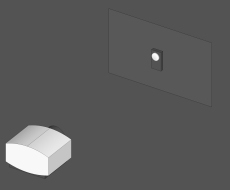
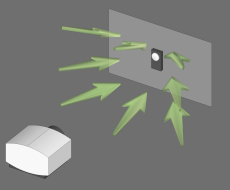
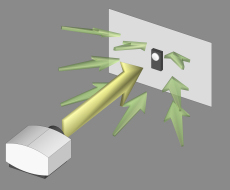
low ambient light
Illuminance is the total amount of visible light illuminating a point on a surface from all directions above the surface. The surface can be a physical or an imaginary surface. The illumintion is the general ‚quantity' of light measured. It is measured with a Lux-Meter. The unit for illuminance is lux. The relationship between lux and lumen is: 1 lux = 1 lumen / square meter.
 |
 |
 |
| lux meter at a projection screen, low ambient light |
higher ambient light | ambient light and projector light |
| for instance 50 lux | 300 lux | 1300 lux |
The illuminance is the sum of all individual light illuminating a surface. By subtracting individual parts other parts can be calculated (example above): The ambience lllumination is 300 lux, the complete illumination is 1300 lux => the illumination caused by the projector is: 1300 lux - 300 lux = 1000 lux. With the known illumination by the projector, the lumen of the projector can be calculated: lumen = lux * square meter.
The Luminance is the so-called luminous flux density in a particular direction. It is corresponding to the object brightness not to the light shining on the object.
The unit for luminance is NIT or cd/m2. The relationship with lumen is: 1 NIT = 1 cd/m2 = 1 lumen per steradian per m2 surface. The candela per square metre (cd/m2) is the SI unit of luminance and NIT is the older non-SI unit mostly used in the US. 1 NIT = 1 cd/m2.
Simplified said the illuminace is all the light that shines on a surface and the luminance is the reflected light from this surface in one direction. Example: Sun light is shining on a wall. All the light reaching this wall is the illuminance. The wall is "illuminated". This light will be the same whether the wall is black or white! But the black wall will reflect much less light than a white wall: the luminance of the wall is very different!
Because the light illuminating a surface is diffuse reflected to all angles in the same way, the on the surface measured illuminance is more than the measured luminance of the reflected light in only one direction. With the mathematical relation between the two (steradian, half sphere), a perfect white diffusive reflecting surface (gain = 1) illuminated with 1 lux has 0.34 NIT luminance. Vice versa a measured 1 NIT luminance is equivalent to a perfect white diffusive reflecting surface illuminated by 3.14 lux.
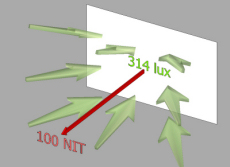
Luminous Flux is the total light output from light sources. The unit is lumen. 1 lumen = 1 candela * steradian. The Luminous Flux takes account to the varying sensitivity of the human eye to different wavelengths of light. Less visible light has a diminished value compared to more visible light ( differs from radiant flux, the measure of the total power of light emitted, in that luminous flux is adjusted to reflect the .
Lumens = {Lux * Area} / {Screen Gain}
ANSI Lumen is the Acronym for American National Standards Institute, ANSI has established the standards for measuring lumen brightness of projectors. The ANSI lumen standards ANSI/NAPM IT7.228-1997 and ANSI/PIMA IT7.227-1998 actually were retired on July 25, 2003.
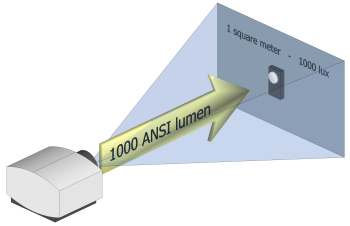
The IEC lumen standard for projectors equals the ANSI standard, but manufacturer hesitate to use a different term than ANSI. The parameter ANSI lumen became too important and the term 'IEC lumen' would confuse the entire projection business.
Probably something like "ANSI/IEC lumens" will emerge during the next few years (ANSI and IEC suggest referring to the IEC standards for testing from now on) ...
The IEC lumen standards are IEC 61947-1 and IEC 61947-2, the testing procedures are basically the same as under ANSI: An IEC lumen is the same as an ANSI lumen!
The calculation of the scattered reflected light from a ideal projection screen with an optimum gain of "1" and 100% reflection to all directions within the 180 degree spatial angle back into the room is:
Illumninance as scattered reflection back into the room = Luminous Flux (Projector) * 2 / ( 4 * Pi * Distance2 )
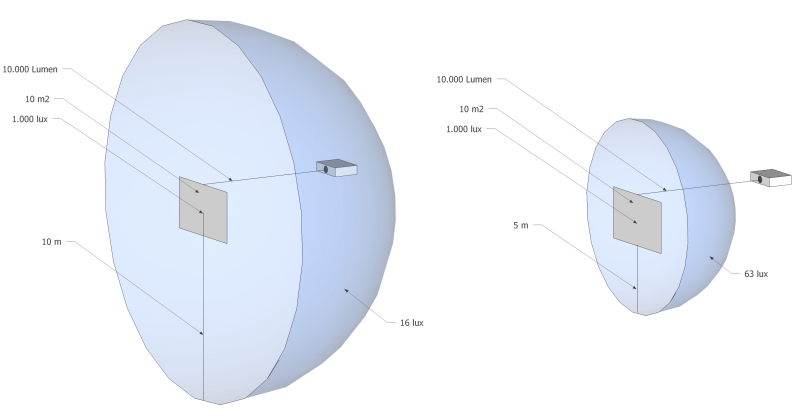
The light from the projector will be 100% (ideal conditions) reflected back into the room in a halfspere (ideal conditions).
The nominal screen luminance for movie theatres is 16 Foot-Lamberts. It was specified by the SMPTE (Society of Motion Picture and Television Engineers) as the minimum for film-type movie theatres. The unit Foot-Lamberts is a measurement related to the brightness of a particular image and is equal to 1 lumen per square foot of screen surface. 16 foot-lamberts is chosen because most films have an ideal balance between black and white saturation conditions at this brightness. A tolerance of 20% between the center brightness and a fall-off of at the screen edges is acceptable.
Even for larger cinemas it is often hard to fulfill this requirement.
| Luminance | |
| NIT or candela per square meter (cd/m2) | |
| 20 - 300 NIT | Brightness of Plasma and TFT Screens |
| 40 - 60 NIT | Cinema Screens |
| 32.000 NIT | Reflecting, Diffusing Surface in Sunlight |
| 2.000 - 7.000 NIT | Sky |
| 1.65 Giga NIT | Sun at Zenith |
| Illuminance | |
| Lux (lumens per square meter) | |
| 1 milli lux | Starlight |
| 0.1 lux | Full Moon |
| 10 lux | Twilight |
| 300 lux | Performance of visual tasks of high contrast and large size |
| 500 lux | Performance of visual tasks of high contrast and small size, or visual tasks of low contrast and large size |
| 1.000 lux | Performance of visual tasks of low contrast and small size |
| 1.000 lux | Overcast Day |
| 100.000 lux | Direct Sunlight |
The first standard chosen was a source that was familiar and common to everybody: a candle. It was a specifically sized candle with specific material and molded in a specific way. The amount of light emitted from such a candle became the first unit of 'brightness'. It was called 'one candlepower'.
Imagine such a candle at the center of an darkened room, the energy of this candle is radiating equally in all directions. The farther the distance from its flame, the less light it appears to be shedding.
Light from a point source (the candle) radiates outward in all directions such that it uniformly illuminates the surface of an ever expanding sphere. As the radius of that sphere gets larger, the surface area grows even more and thus the energy from the candle is spread ever thinner.
This is the 'Inverse Square Law' (the radius of the sphere is R,
the surface of the sphere is 4x R2).
The Illuminating Engineering Society of North America (IESNA) established illuminance categories. These seven categories are based on descriptions of various visual tasks:
|
Category |
Space |
Illuminance |
|
| Orientation and simple visual tasks |
A |
Public spaces | 30 lux |
| B | Simple orientation for short visits | 50 lux | |
| C | Working spaces where simple visual tasks are performed | 100 lux | |
| Common visual tasks | D | Performance of visual tasks of high contrast and large size | 300 lux |
| E | Performance of visual tasks of high contrast and small size, or visual tasks of low contrast and large size | 500 lux | |
| F | Performance of visual tasks of low contrast and small size | 1000 lux | |
| Special visual tasks | G | Performance of visual tasks near threshold |
3,000 to 10,000 lux |